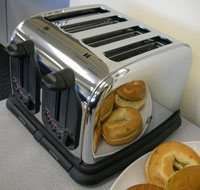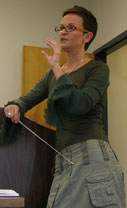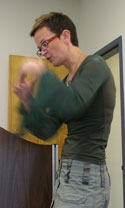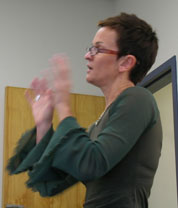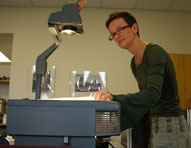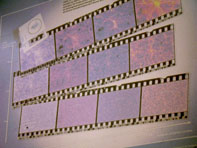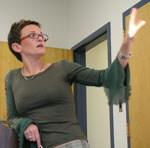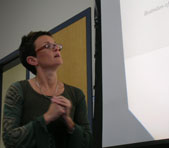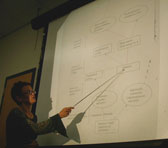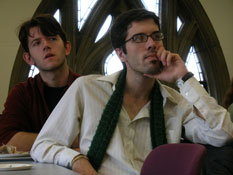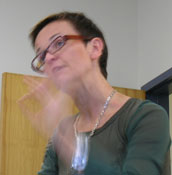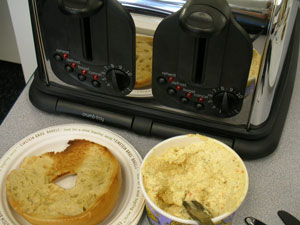
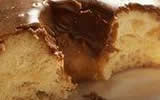
![]()
::: postdoc fellowships
::: senior fellowships
::: resident fellowships
::: associateships
![]()
being here
::: visiting
::: the last donut
::: photo album
::: center home >> being here >> last donut? >> 6 October 2006 |
Friday, 6 October 2006 Sometimes preliminaries are important at a talk, especially when the newcomer in the room has not been noticed. So, with just a little flourish, I introduced our shiny new, four slot toaster. It would, by popular demand, transform the fresh, doughy bagels brought to every lunchtime talk to toasty perfection. It has been Jim Tabery's idea originally. In an impromptu thought during the introductory remarks, he christened it "Hal." Now that our appetites for carbohydrates and cream cheese had been satisfied, we could turn to our quite remarkable speaker. Stéphanie Ruphy, one of this year's Visiting Fellows, has just the sort of glorious mixed background that makes philosophers of science so interesting. She has studied sciences and humanities in French and American universities. She has earned a bachelors, masters and doctoral degree in philosophy; and she has a bachelors in aeronautical engineering, along with a private pilot's license, as well as masters and doctoral degrees in astrophysics. When she speaks about the models used in astrophysics, there is little doubt that she speaks with authority. As she begins speaking, it begins to become clear she is unhappy about the astrophysical and cosmological models she knows so well. The ideas develop with the usual philosopher's speak. Do computer simulations inherit the epistemic credentials of their parent theories? Or do they have a kind of autonomy? What of the path dependence that leads to their construction? What of the untestable principles that are used in all cosmological theories and built into simulations? Do we need a new epistemology for computer simulations? Should we not take an antirealist attitude to these models? What is worrying her, I kept asking myself. Computer simulations in astrophysics and cosmology seem to be doing extremely well. I thought of the enthusiastic reports I'd read and lavish illustrations of them in popular science magazine. Here was one. She was displaying some gorgeous pictures of galaxies in vibrant colors. "Of course they are simulations," she says. Simulations? Then I get it. The images are presented as frames on old fashioned 35mm slide film. I see the familiar sprocket holes along each edge and the frame numbers from the end of a roll of 36 exposures--31, 32, 33--on the borders. I'd spent many hours in a darkroom and these were unmistakable cues to authenticity. These are the raw images developed on the film of a 35mm camera. They are as close as any observer can now come to the original event. But no, they are simulations. There is no original event! The faux realistic presentation is pure artistic license that gives a false impression of solidity to the images. That is what is worrying Stéphanie. She has seen how the simulations behind the images were made. They depend upon large numbers of arbitrary assumptions that someone has to go back to and check. But that wasn't happening. The simulations were fitting the available data well enough. And when they didn't, a bit of adjustment here or there in the parameters and the fit was restored. Somewhere, somehow they'd lost track of the fact that the models were a few of very many, all of which could be made to fit equally well to the observations available. Happenstance had led to this particular model. Through familiarity, happenstance was becoming discovered fact. Of course Stphanie's worry was not specifically those faux realistic images she'd shown us. It turned out that she had been responsible for their being presented that way, she explained later to me. She had commissioned them in an earlier life as a science journalist. Her worry was just how readily her field was taking the simulations as factual, so the faux realism would pass as unremarkable. The dynamic was all too clear. The models used in the simulations had so many free parameters to adjust that no mismatch with observation was ever likely. The models are too plastic. We need rigidity, she pleaded. As the talk drew to a close, Stéphanie recalled that these thoughts are work in progress. Where could she go now to develop them? That is where question time picked up with a wide variety of responses. Perhaps, Peter suggested, it wasn't that bad. Isn't this sort of proliferation of models just what real science looks like? Stéphanie was not comforted. I tried to suggest that a new epistemology might not be needed. I've been impressed by Wendy Parker's work, which has convinced me that the essential epistemology of real, material experiments, computer simulations and even theoretical modeling are the same. Stphanie had a thoughtful look in her eyes and I began to suspect that is was politeness preventing her telling me why she didn't believe it. Then our time was up and the last lingering interlocutor wandered off. As a speaker, you don't really sense how hungry you are until after the talk is over and your mind finally rests. Stephanie walked the seven steps to the toaster and soon had a perfectly toasted bagel ready for the cream cheese. She humored me and let me arrange that very bagel in front of the toaster for a photo. John D. Norton |
